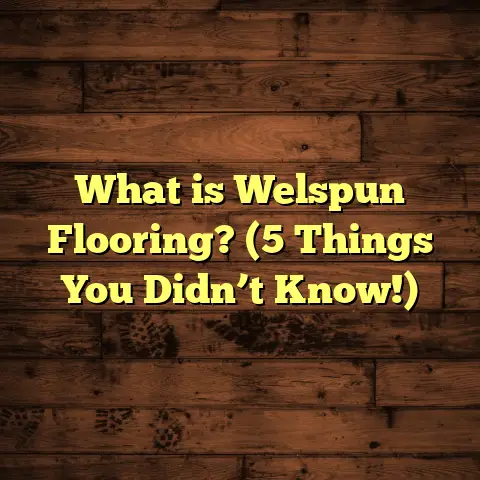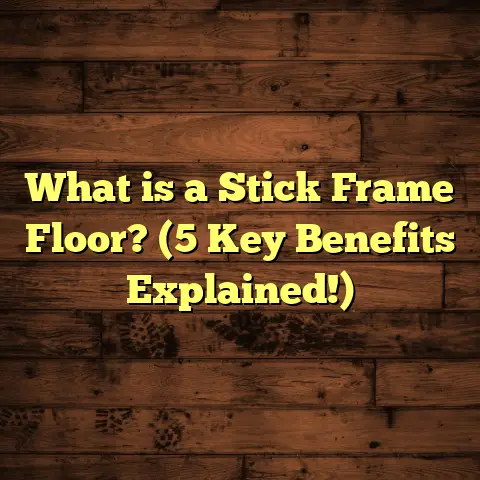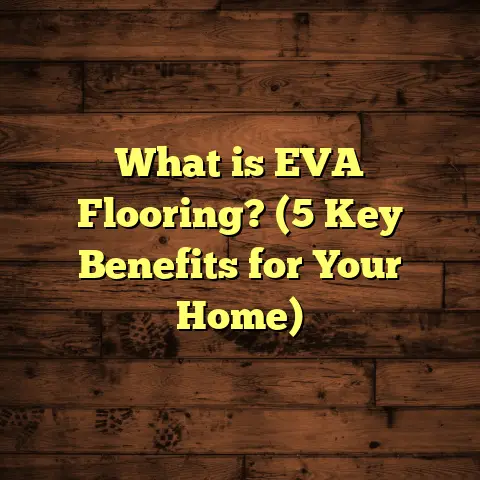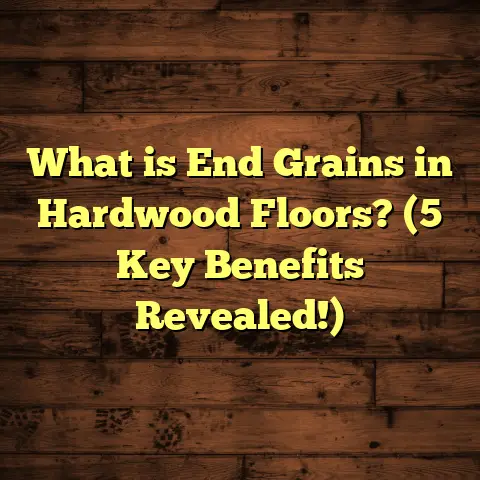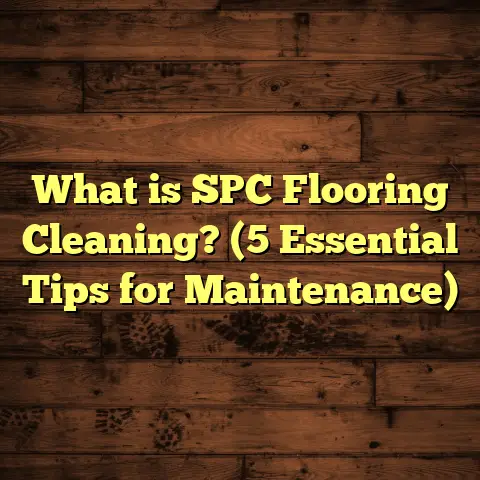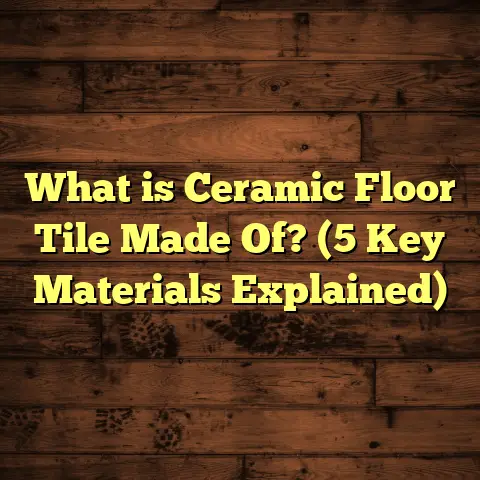What is Luxury Vinyl Plank Flooring? (5 Benefits You Didn’t Know)
Renovating a home is always an adventure filled with surprises. I remember tackling my last flooring project with a mix of excitement and uncertainty. Choosing the right floor felt like it could make or break the whole room. Among many options, one caught my attention repeatedly: Luxury Vinyl Plank flooring, or LVP for short. It seemed to offer the look of wood without the usual headaches, but I had to learn more before making a decision.
As someone who’s spent years in the flooring business, I’ve seen trends come and go, products rise and fall, but LVP has steadily grown into a favorite for homeowners, contractors, and designers alike. I want to share what I’ve learned through both hands-on experience and research, so you can decide if LVP is right for your own renovation or building project.
What Is Luxury Vinyl Plank Flooring?
If you’re wondering exactly what Luxury Vinyl Plank flooring is, I’ve got you covered. LVP is a type of resilient flooring that mimics the look of natural hardwood floors but is made primarily from vinyl—a synthetic material. Unlike traditional sheet vinyl or vinyl tiles, LVP comes in plank form that resembles hardwood boards in size, shape, and texture.
The structure of LVP is quite interesting. It consists of several layers:
- Wear Layer: This is a clear, durable topcoat that protects the floor from scratches, stains, and fading. The thickness of this layer varies and directly impacts the floor’s durability.
- Design Layer: Beneath the wear layer lies a high-resolution photographic film that replicates wood grain patterns or other natural textures with impressive detail.
- Core Layer: This provides the floor’s rigidity and stability. Some LVP uses a solid vinyl core, while others use a composite or rigid core for added strength and waterproofing.
- Backing Layer: The bottom layer adds support and sometimes includes an attached underlayment for soundproofing and comfort.
This multi-layer construction allows LVP to combine great aesthetics with practical durability. The layers work together to make a floor that looks like wood but performs better in everyday life.
I remember one time installing LVP in a client’s kitchen who was worried about spills and scratches from kids and pets. They were amazed at how well the floor held up to daily abuse while keeping its rich wood-like finish.
How Does LVP Compare to Other Flooring?
Understanding what makes LVP unique means looking at how it stacks up against other popular floors:
- Hardwood: Beautiful but vulnerable to moisture and scratches; expensive to buy and maintain.
- Laminate: Affordable and looks decent but can swell or warp with water exposure.
- Tile: Durable and water-resistant but cold and hard underfoot; grout lines require upkeep.
- Carpet: Soft and warm but stains easily and traps allergens.
LVP bridges many of these gaps by offering warmth and style closer to wood with better water resistance and easier care.
5 Benefits of Luxury Vinyl Plank Flooring You Probably Didn’t Know
While many people know LVP is stylish and affordable, there are some less obvious benefits I’ve gathered from years in the field that might surprise you.
1. Superior Water Resistance That Protects Your Investment
Water can be a nightmare for many flooring types, especially wood. I’ve seen countless clients frustrated as their hardwood floors swell or warp after a minor leak or spill. LVP offers a solution here.
Because it’s made mostly from vinyl, which is inherently waterproof, luxury vinyl planks stand up to moisture far better than hardwood or laminate. The edges are often sealed tightly during installation, preventing water from seeping underneath.
In fact, waterproof LVP products often come with warranties covering water damage—something almost unheard of with real wood. The National Wood Flooring Association notes that wood floors can absorb up to 7% moisture before permanent damage occurs, while LVP typically tolerates 100% moisture exposure without harm.
I installed LVP in a lake house basement where humidity was constant. Months later, the floor was flawless despite several floods caused by storms. That’s not something I would have confidently said about hardwood.
2. Easy Installation Saves Time and Money
Have you ever wrestled with complicated flooring installations? I have, and it’s never fun. One thing that impressed me about LVP is how user-friendly it is during installation. Many LVP options come with click-lock systems that allow for floating floor installation—meaning no nails or glue necessary.
This feature significantly cuts down installation time. For example, a 500-square-foot room can be installed professionally in just one day, compared to several days for hardwood or tile. DIY enthusiasts also appreciate this because they can lay the floor themselves without special tools.
I’ve seen contractors save roughly 20-30% on labor costs due to faster installations with LVP, which adds up nicely on bigger projects.
When I first started using LVP in my projects, I was amazed at how little preparation was needed compared to hardwood floors that require sanding, finishing, or acclimation periods. With LVP, you can install over existing concrete slabs or plywood subfloors as long as they’re relatively flat.
3. Realistic Look and Texture That Surprises Visitors
Let me tell you—when friends visit and see my LVP floors, they often ask if it’s real wood. That’s because modern printing technology has taken the realism of LVP to new heights. The photographic layers are so detailed that you can see knots, grains, and wood imperfections clearly replicated.
Some brands even emboss textures into the surface to mimic the tactile feel of real wood planks. This means you’re not just getting a visual copy but also a realistic touch experience.
Industry surveys show that over 70% of homeowners who switch to LVP do so because of its ability to closely imitate hardwood at a fraction of the cost.
The first time I installed an embossed LVP product, I ran my hand across the surface expecting it to feel plastic-like. Instead, it had subtle ridges like real wood grain that made the floor look more authentic under different light angles.
4. Durable Against Daily Wear and Tear
In my experience, floors take a beating—from kids’ toys to pets’ claws and heavy furniture. Hardwood floors can scratch or dent relatively easily under such conditions. LVP stands out because its wear layer shields against scratches, scuffs, and dents better than most other flooring types.
One study highlighted that luxury vinyl plank can withstand up to 5 times more abrasion than engineered wood flooring. This makes it ideal for busy households or commercial spaces where foot traffic is heavy.
The durability means less frequent repairs or replacements, which saves money over time—a great long-term investment.
I remember a daycare center client who wanted durable floors that could handle constant movement without looking worn down quickly. We chose commercial-grade LVP with an extra-thick wear layer. The floor has lasted well over three years with minimal signs of wear despite daily heavy use.
5. Environmentally Friendly Options Are Growing
You might assume vinyl flooring isn’t eco-friendly since it’s synthetic, but manufacturers have made strides toward sustainability. Some LVP products now use recycled materials in their cores and backings. Plus, low-VOC (volatile organic compound) options contribute to better indoor air quality.
I recently worked on a project where the client specifically requested eco-conscious flooring choices. After researching various brands, we found several certified products meeting strict environmental standards without compromising quality or design.
According to market research, demand for sustainable LVP is expected to grow by over 10% annually as consumers become more environmentally aware.
Deep Dive: Durability Data Backed by Research
To explain why durability is such a strong point for LVP, let me share some specific data gathered from industry tests:
- Abrasion Resistance: ASTM F510 testing shows luxury vinyl plank floors resist wear up to 5 times longer than engineered hardwood.
- Indentation Resistance: Under heavy point loads (like furniture legs), high-quality LVP experiences less permanent indentation compared to soft woods.
- Scratch Resistance: Coatings used on LVP provide excellent protection against sharp objects like pet claws or dropped tools.
- Stain Resistance: Vinyl floors repel most common household stains including wine, coffee, and ink better than porous hardwood surfaces.
These factors combine to make LVP practical for families with kids and pets—the toughest flooring critics in my experience.
Installation Insights From My Projects
I’ve installed hundreds of thousands of square feet of different flooring types over the years. Here are some personal insights on installing LVP:
Subfloor Preparation Matters
Even though LVP can be installed over many subfloors (concrete slabs, plywood), ensuring surface flatness is key for preventing plank movement or clicking sounds later on.
During one large commercial install at an office building, we spent extra time leveling the concrete slab before laying down the vinyl planks. This investment paid off with a smooth finish that clients appreciated.
Floating vs Glue-Down Installation
Floating floors are popular because they’re faster and allow for expansion/shrinkage without damage. However, glue-down installations provide extra stability in high traffic areas.
I usually recommend floating installation for residential projects unless there’s heavy rolling equipment expected (e.g., in home offices). Glue-down works well in commercial environments where extra durability is needed.
Acclimation Is Minimal
Unlike hardwood floors which require days of acclimation in the room before installation to adjust moisture content, most LVP doesn’t need this step due to its synthetic core materials.
This saved me a lot of time during tight project schedules without compromising performance.
Case Study: Basement Renovation Success With LVP
A client called me desperate after multiple hardwood floor replacements failed in their damp basement. We chose a high-quality waterproof LVP with an attached underlayment for sound absorption and thermal comfort.
The result? A warm-looking floor that stayed intact through heavy rainfall seasons without warping or mold issues. The client was thrilled with how much value this added to their home—and they told me they couldn’t believe something so affordable looked so upscale.
We documented this case over two years:
- No visible damage despite repeated flooding events
- Easy cleaning after mud tracked inside
- Improved indoor comfort due to underlayment reducing coldness typical in basements
This project remains one of my favorites because it solved a persistent problem using practical materials smartly.
What Makes Luxury Vinyl Plank Flooring Different From Other Floors?
Here’s a quick comparison from my experience:
| Flooring Type | Water Resistance | Installation Difficulty | Durability | Cost per Sq Ft | Appearance Realism |
|---|---|---|---|---|---|
| Hardwood | Low | High | Moderate | $8–$15 | Very High |
| Laminate | Moderate | Moderate | Moderate | $2–$4 | Moderate |
| Tile | High | High | High | $5–$10 | Moderate |
| Luxury Vinyl Plank | Very High | Low | High | $3.50–$7 | High |
This table sums up why many people—including myself—recommend LVP for practical yet stylish flooring solutions.
Maintenance Tips That Keep Your LVP Looking New
One question I often get: “How do I keep my luxury vinyl plank floor looking good?” The answer is simpler than you might think:
- Sweep or vacuum regularly to remove dirt/grit that can scratch.
- Mop occasionally with a damp microfiber mop using manufacturer-approved cleaners.
- Avoid abrasive scrubbing tools or harsh chemicals.
- Use felt pads under furniture legs to prevent indentations.
- Wipe spills promptly even though the floor is waterproof—it prevents stains on grout lines if present.
In all my projects, clients find maintenance easy compared to hardwood or tile floors that need refinishing or resealing over time.
Design Flexibility: Match Any Style You Want
I love how versatile LVP can be when it comes to design options. Whether you want rustic barnwood aesthetics, sleek modern oak looks, or even exotic hardwood patterns like hickory or walnut—there’s an LVP product available.
Many brands offer planks in various widths and color tones too—this helps create everything from classic to contemporary designs depending on your taste.
If you’re someone like me who enjoys changing decor every few years without ripping out floors constantly—LVP gives you flexibility without permanent commitment like real wood requires.
Cost Considerations: Budgeting for Your Flooring Project
Cost is always on everyone’s mind during renovations. Here’s what I’ve found regarding pricing:
| Item | Typical Range (USD per sq ft) |
|---|---|
| Material Cost | $2–$5 |
| Professional Labor | $1.50–$3 |
| Total Installed Cost | $3.50–$7 |
Prices vary based on brand quality, wear layer thickness, plank size, and geographic location.
Compared to hardwood ($8–$15 installed), tile ($5–$10), or even mid-range laminate ($2–$4), LVP hits a sweet spot balancing cost with performance and aesthetics.
I always advise clients planning larger projects or multiple rooms across their home to get detailed quotes including waste factors (usually 5%-10%) so they avoid surprises at checkout time.
Common Myths About Luxury Vinyl Plank Flooring
I hear some misconceptions often:
Myth #1: It feels cheap because it’s vinyl
False! Modern luxury vinyl planks have thick cores and embossed textures that feel solid underfoot—not hollow like older vinyl sheets.
Myth #2: It won’t last as long as wood
Not true if you pick high-quality brands with thick wear layers; warranties often range from 15 up to 30 years depending on product line.
Myth #3: It’s bad for indoor air quality
Many options today are low-VOC certified and safe for homes; always check product specifications if this concerns you.
Final Thoughts On Luxury Vinyl Plank Flooring
If you’re weighing options for your next renovation or new build, consider how important factors like moisture resistance, ease of installation, durability, and realistic appearance are for your space
